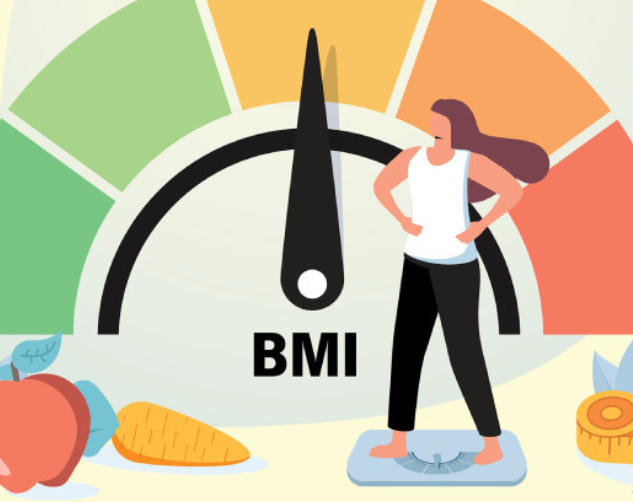Based on your height and weight, your body mass index (BMI) estimates how much fat you have. Some diseases can be diagnosed using this method. In adults and children, body mass index does not always accurately estimate body fat, and it is calculated differently. Stay with us until the end of the article to learn more about BMI.

How does body mass index work?
It is calculated by multiplying the weight (in kilograms) by the square of the height (in square meters) to estimate the amount of body fat. In most people, this number corresponds to the amount of body fat, but it is not necessarily accurate and cannot be used to determine a person’s health. Due to this, a doctor uses other tests to check a person’s health status in addition to BMI.
Why is body mass index important?
The risk of heart disease, stroke, and type 2 diabetes increases with excess body fat. Malnutrition can also cause too little body fat. Body fat helps the body absorb vitamins and minerals, provides energy, maintains body temperature, and protects organs when it is in the right amount. As a result, this index is very important for estimating body fat levels.
Body mass index is used for the following purposes:
1. Weight classification:
In this case, you are underweight and should increase your weight with the help of a nutritionist.
With a BMI of 18.5 to 24.9, you have a suitable weight and are less likely to suffer from serious diseases considering your height.
In order to maintain your health, it is better to lose weight if you are overweight (BMI 25 to 29.9).
In order to maintain your health, you need to lose weight with the help of a nutritionist if your body mass index exceeds 30. The obesity index divides obesity into three categories:
Class 1 obesity: BMI 30 to 34.9.
Class 2 obesity: BMI 35 to 39.9.
Class 3 obesity: BMI greater than 40.
In addition to BMI, other tools are also used to categorize weight types, such as:
Measurement of waist circumference;
In certain areas of the body, such as the back of the arms and under the shoulder blades, measuring skin folds;
An air displacement plethysmogram and a DEXA scan.

2. Examining the possibility of contracting a disease:
You are more likely to have some diseases if your body mass index is less than 18.5.
Malnutrition;
Anemia;
Infections and diseases are more likely to occur due to a weakened immune system;
Osteoporosis;
sterility.
Other diseases associated with a high body mass index include:
Heart disease;
high blood pressure;
type 2 diabetes;
Gallstone;
arthritis;
sleep apnea;
Mental illnesses such as depression;
Cancers such as colon, breast, gall bladder, and endometriosis.
It is possible to get the diseases mentioned above even without a high physical index. It is also possible to have a high BMI without having any of these diseases. These diseases are caused by genetics and other factors such as smoking.
BMI has the following limitations:
1. Types of weight cannot be detected due to the following limitations:
The BMI does not differentiate between lean mass (the volume of everything except fat in the body) and fat mass. As a result, someone with a high BMI may have a very low fat mass, but a high BMI due to being muscular.
While women tend to have more fat than men, this index does not differentiate between men and women.
The height of adults has increased over the years, so this index has not been updated.
Some people should not use body mass index, including:
Bodybuilders and athletes;
Teenagers and children;
Women who are pregnant;
Over 65-year-olds;
Muscle wasting caused by disease.
2. Diagnosis limitations:
It is used to diagnose diseases like type 2 diabetes and heart disease, but it has limitations, including:
Fat distribution and location are not determined by body mass index. The effect of fat accumulation in one part of the body, such as the abdomen, is different from that of fat accumulation in another part of the body, such as the thighs.
Family history of diabetes, high blood pressure, cardiovascular disease, high cholesterol, and cancer are not taken into account when examining BMI’s association with mortality.
Children and adolescents’ body mass index:
Neither men nor women have different body mass indices based on their age. Children and adolescents have slightly different BMIs. At different ages, boys and girls grow at different rates and have different levels of body fat. In childhood and adolescence, BMI is calculated based on age and gender.
For a variety of reasons, doctors and specialists do not categorize children by weight, including:
Every month, their weight changes;
Boys and girls have different body types;
Height affects weight.
Frequently asked questions
1. What is the formula for calculating body mass index?
In other words, divide your weight in kilograms by your height in meters, then divide the result by your height in meters again. Divide 60 kg by 2.56 if your weight is 60 kg and your height is 1 meter 60 cm. As a result, your BMI will be 23.43, which is within the normal range.
2. What is a normal BMI?
Normal body mass indexes range from 18.5 to 24.9, and a best body mass index cannot be determined. Keep in mind that body fat is not the only indicator of health. Your overall health is influenced by genetics, physical activity, lifestyle, and mental health.
3. Does body mass index have a limit?
Yes, of course. There are a number of limitations to the standard body mass index chart. It’s important not to put too much emphasis on your BMI. It is, however, the fastest method of assessing body fat.


